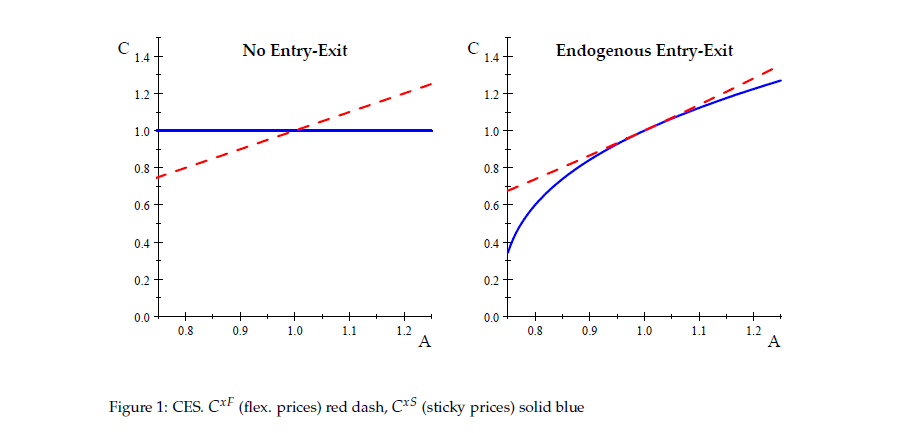1/n Need holiday reading?
New paper w/ 𝐌𝐚𝐫𝐜 𝐌𝐞𝐥𝐢𝐭𝐳:
"𝐴𝑔𝑔𝑟𝑒𝑔𝑎𝑡𝑒-𝐷𝑒𝑚𝑎𝑛𝑑 𝐴𝑚𝑝𝑙𝑖𝑓𝑖𝑐𝑎𝑡𝑖𝑜𝑛 𝑜𝑓 𝑆𝑢𝑝𝑝𝑙𝑦 𝐷𝑖𝑠𝑟𝑢𝑝𝑡𝑖𝑜𝑛𝑠: 𝑇𝘩𝑒 𝐸𝑛𝑡𝑟𝑦-𝐸𝑥𝑖𝑡 𝑀𝑢𝑙𝑡𝑖𝑝𝑙𝑖𝑒𝑟"
https://tinyurl.com/yc3j7g2t
Slides https://tinyurl.com/y8yt4dbm
A Thread
New paper w/ 𝐌𝐚𝐫𝐜 𝐌𝐞𝐥𝐢𝐭𝐳:
"𝐴𝑔𝑔𝑟𝑒𝑔𝑎𝑡𝑒-𝐷𝑒𝑚𝑎𝑛𝑑 𝐴𝑚𝑝𝑙𝑖𝑓𝑖𝑐𝑎𝑡𝑖𝑜𝑛 𝑜𝑓 𝑆𝑢𝑝𝑝𝑙𝑦 𝐷𝑖𝑠𝑟𝑢𝑝𝑡𝑖𝑜𝑛𝑠: 𝑇𝘩𝑒 𝐸𝑛𝑡𝑟𝑦-𝐸𝑥𝑖𝑡 𝑀𝑢𝑙𝑡𝑖𝑝𝑙𝑖𝑒𝑟"
https://tinyurl.com/yc3j7g2t
Slides https://tinyurl.com/y8yt4dbm
A Thread
2/n Entry-exit central in the COVID-19, i.a. @skalemliozcan @pogourinchas @JHaltiwanger_UM
We built endogenous-entry business-cycle Macro models for ~2 decades, joint work w/ @FabioGhironi
We revisit that model class to understand the role of entry-exit in COVID-19 recession
We built endogenous-entry business-cycle Macro models for ~2 decades, joint work w/ @FabioGhironi
We revisit that model class to understand the role of entry-exit in COVID-19 recession
3/n -> build a theory of aggregate-demand AD amplification of supply disruptions.
Contributions/Results:
𝐓𝐡𝐞 𝐄𝐧𝐭𝐫𝐲-𝐄𝐱𝐢𝐭 𝐌𝐮𝐥𝐭𝐢𝐩𝐥𝐢𝐞𝐫: The endogenous response of entry-exit to a TFP shock is amplified by sticky prices P.
Contributions/Results:
𝐓𝐡𝐞 𝐄𝐧𝐭𝐫𝐲-𝐄𝐱𝐢𝐭 𝐌𝐮𝐥𝐭𝐢𝐩𝐥𝐢𝐞𝐫: The endogenous response of entry-exit to a TFP shock is amplified by sticky prices P.
4/n The entry-exit response w/ sticky P is θ >1, θ elasticity of demand/substitution btw goods. It is 1 under flexible P. (U=lnC & C a CES aggreg) Reason: flex P→increase P when bad shock. If cannot (sticky P)→losses→exit, further (endogenous) TFP-like round, etc:
A Multiplier
A Multiplier
5/n Works in any model w/ endog. entry & sticky P, astonishingly not noticed before (including by us).
NOW: Is 𝐚𝐠𝐠𝐫𝐞𝐠𝐚𝐭𝐞 𝐚𝐜𝐭𝐢𝐯𝐢𝐭𝐲 similarly amplified? YES. Remember first with no entry, standard model (no capital): w/ flex P, TFP fall by 1 = fall in C & Y by 1.
NOW: Is 𝐚𝐠𝐠𝐫𝐞𝐠𝐚𝐭𝐞 𝐚𝐜𝐭𝐢𝐯𝐢𝐭𝐲 similarly amplified? YES. Remember first with no entry, standard model (no capital): w/ flex P, TFP fall by 1 = fall in C & Y by 1.
6/n w/ sticky P (labor elastic, no rationing) + quantity equation:
TFP ↓ does nothing to C & Y (L ↑ to produce more, optimal as profits ↓ income effect).
Standard, known NK problem
𝐄𝐧𝐝𝐨𝐠𝐞𝐧𝐨𝐮𝐬 𝐄𝐧𝐭𝐫𝐲-𝐞𝐱𝐢𝐭 𝐟𝐥𝐢𝐩𝐬 𝐭𝐡𝐢𝐬!
TFP ↓ does nothing to C & Y (L ↑ to produce more, optimal as profits ↓ income effect).
Standard, known NK problem
𝐄𝐧𝐝𝐨𝐠𝐞𝐧𝐨𝐮𝐬 𝐄𝐧𝐭𝐫𝐲-𝐞𝐱𝐢𝐭 𝐟𝐥𝐢𝐩𝐬 𝐭𝐡𝐢𝐬!
7/n Flex P→already amplification of TFP disruption, standard variety effect i.a. BGM JPE 2012: C & Y fall by x>1.
But w/ sticky P, Y falls by more X(da)>x. Larger disruption da→larger amplification.
Several features drive this when added to our entry-exit multiplier:
But w/ sticky P, Y falls by more X(da)>x. Larger disruption da→larger amplification.
Several features drive this when added to our entry-exit multiplier:
8/n concavity of C function in number of varieties; inefficiently low entry in market equilibrium (->amplification to first order)
So, negative TFP→positive output gap w/o entry, negative with entry-exit (potential output falls by more, but stick-P output falls by even more).
So, negative TFP→positive output gap w/o entry, negative with entry-exit (potential output falls by more, but stick-P output falls by even more).
9/n Corollary: mind the nonlinearities! Linearizing may miss the whole point (w/ CES, you see nothing at the 1st order; COVID-19 shock very large).
10/n Important side result: response of hours w/ entry-exit is similar across flex-sticky P. Unlike no-entry model, where sticky P→hours countercyclical to TFP.
Here, procyclical, related to Y gap response.
Profits make hours go wild w/ no entry, entry-exit cleans them up
Here, procyclical, related to Y gap response.
Profits make hours go wild w/ no entry, entry-exit cleans them up
11/n W/ CRRA utility, generalized requirement for both entry-exit multiplier & AD amplification
θ > σ
(σ Elast. Intertemp. Subst. EIS)
Entirely plausible: θ > 4, σ < 2. (w/ U=lnC restriction θ >1)
θ > σ
(σ Elast. Intertemp. Subst. EIS)
Entirely plausible: θ > 4, σ < 2. (w/ U=lnC restriction θ >1)
12/n
θ > σ is the OPPOSITE of 𝑠𝑒𝑚𝑖𝑛𝑎𝑙 @VeronicaGuerri7 @guido_lorenzoni @ludwigstraub Werning paper (2-sector, rep-agent part)
Difference: here, endogenous change in number of varieties to aggregate TFP (there, sectoral TFP, as if exogenous fall in number of varieties).
θ > σ is the OPPOSITE of 𝑠𝑒𝑚𝑖𝑛𝑎𝑙 @VeronicaGuerri7 @guido_lorenzoni @ludwigstraub Werning paper (2-sector, rep-agent part)
Difference: here, endogenous change in number of varieties to aggregate TFP (there, sectoral TFP, as if exogenous fall in number of varieties).
13/n Here, both intensive & extensive margins->aggreg. C Our condition
→ extensive margin elastic enough → aggregate C amplified even though intensive margin dampened.
→ Edgeworth substitutability of individual goods in utility (GLSW=complementarity)
→ extensive margin elastic enough → aggregate C amplified even though intensive margin dampened.
→ Edgeworth substitutability of individual goods in utility (GLSW=complementarity)
14/n Our complementary mechanism: 𝐞𝐧𝐝𝐨𝐠𝐞𝐧𝐨𝐮𝐬 entry-exit, extensive-margin.
We abstract from interesting and important two-agent liquidity-constrained mechanism that GLSW find relaxes θ < σ and complementarity.
We abstract from interesting and important two-agent liquidity-constrained mechanism that GLSW find relaxes θ < σ and complementarity.
15/n More loosely related to other COVID-19 amplif. theories @DBaqaee Farhi, @LucaFornaro3 Wolf, Woodford
Vast entry literature: Corsetti Bergin Jaimovich @FZanettiOxford Colciago @lorenzarossi3 @chrisedmond @virgiliu79 @Basile_G etc.
Let us know if we missed a relevant paper!
Vast entry literature: Corsetti Bergin Jaimovich @FZanettiOxford Colciago @lorenzarossi3 @chrisedmond @virgiliu79 @Basile_G etc.
Let us know if we missed a relevant paper!

 Read on Twitter
Read on Twitter



